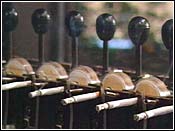Submitted by Anne Landman on
 The U.S. Federal Trade Commission (FTC) is considering stopping use of the "FTC Method" to determine the amounts of tar and nicotine in cigarettes, a test that tobacco companies have touted on cigarette packs for over 40 years and have long used to market "light," "ultralight" and "low tar" cigarettes. The FTC started using the "Cambridge Filter Method" to test for tar and nicotine in 1966, when public health authorities believed that reducing the amount of tar in cigarettes would reduce the risk of lung cancer. In recent years, evidence has proven the test meaningless because it was found that smokers "compensate," or adjust how they smoke, to get the amount of nicotine they need from a cigarette, regardless of nicotine content. Senators Frank Lautenberg (D-New Jersey) and Olympia Snowe (R-Maine) have introduced a bill to stop cigarette companies from using the "FTC Method" to measure tar and nicotine. "For years, Big Tobacco has relied on the FTC's flawed testing method to mislead smokers into thinking these ['light' and 'low tar'] cigarettes deliver less tar and nicotine...In reality, some so-called 'light' and 'low tar' cigarettes can actually be more harmful for smokers," Lautenberg said.
The U.S. Federal Trade Commission (FTC) is considering stopping use of the "FTC Method" to determine the amounts of tar and nicotine in cigarettes, a test that tobacco companies have touted on cigarette packs for over 40 years and have long used to market "light," "ultralight" and "low tar" cigarettes. The FTC started using the "Cambridge Filter Method" to test for tar and nicotine in 1966, when public health authorities believed that reducing the amount of tar in cigarettes would reduce the risk of lung cancer. In recent years, evidence has proven the test meaningless because it was found that smokers "compensate," or adjust how they smoke, to get the amount of nicotine they need from a cigarette, regardless of nicotine content. Senators Frank Lautenberg (D-New Jersey) and Olympia Snowe (R-Maine) have introduced a bill to stop cigarette companies from using the "FTC Method" to measure tar and nicotine. "For years, Big Tobacco has relied on the FTC's flawed testing method to mislead smokers into thinking these ['light' and 'low tar'] cigarettes deliver less tar and nicotine...In reality, some so-called 'light' and 'low tar' cigarettes can actually be more harmful for smokers," Lautenberg said.
